Part V:
George Melies is Tripping on the Sun
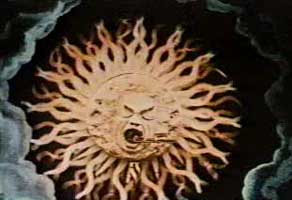 Based on a stage play of the same name by Jules Verne, George Melies' The Voyage through the Impossible (Le Voyage a travers l'Impossible, 1904) served as a sequel to A Trip to the Moon (la Voyage dans la lune, 1902).
Based on a stage play of the same name by Jules Verne, George Melies' The Voyage through the Impossible (Le Voyage a travers l'Impossible, 1904) served as a sequel to A Trip to the Moon (la Voyage dans la lune, 1902).
 Though not the equal of the A Trip to the Moon, that's only because that degree of astounding artfulness is not easily duplicated at will, though most certainly The Voyage through the Impossible is a film with its own extraordinary merits. Though not the equal of the A Trip to the Moon, that's only because that degree of astounding artfulness is not easily duplicated at will, though most certainly The Voyage through the Impossible is a film with its own extraordinary merits.
Verne did not start the craze for air, sea, & lunar journeys to places far & fantastical. The "fantastic voyage" genre dates easily to the 1700s in French literature. So Melies, imaginative as he admittedly was, nevertheless presented audiences with something familiar, no matter how strange.
This was one of the longer hand-tinted color films Milies made. It begins with a meeting of the members of a geographic society gathered around a globe to discuss the funding for a journey. The presence of the globe implies it's supposed to be a "round the world" journey, but this is certainly not what unfolds.
Engineer Krisoloff (Melies) arrives as guest lecturer to lay out his plans for the trip, which will involve all methods of mobility. He unfolds a large poster depicting the journey, showing a drawing of the episode of driving a train engine into the sky which will occur later. His journey will incorporate automobiles, trains, dirigibles, & submarines, whatever it takes to circle the earth by land & sea.
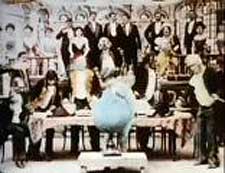 We next see Krisoloff's workspace, a warehouse sized building with large machinery for designing travel devices, & a beautiful set this is. There's a large cast of workers & geographic society visitors to the experimental engineering laboratory. It has just the right balance of realism & the fantastic to set a plausible mood for the implausible journey that will follow. We next see Krisoloff's workspace, a warehouse sized building with large machinery for designing travel devices, & a beautiful set this is. There's a large cast of workers & geographic society visitors to the experimental engineering laboratory. It has just the right balance of realism & the fantastic to set a plausible mood for the implausible journey that will follow.
He shows the visitors his submarine before repairing to another room where further equipment is being fashioned, with some pyrotechnics getting everyone over excited.
The next set is a baggage terminal where the men & women who are going on this expedition prepare to start the journey by train, with slapstick encounters as everyone dashes about in a hurryscurry getting their travel trunks & themselves on board. Throughout there's a tophat in the middle of the terminal floor, which no one ever claims -- a very small bit of drama since those hats were a mite expensive to risk crushing.
The train's journey through the alps is gorgeously designed, incorporating both miniatures & backdrop paintings. Among the train's cars are those which carry the dirigible, automobile, & submarine.
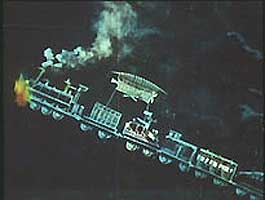 Disembarking in the alps, everyone piles into the automobile. In the first totally absurd moment, they drive through a large inn where a crowd's meal is disrupted by a the unusual automobile journeying through the dining hall. Disembarking in the alps, everyone piles into the automobile. In the first totally absurd moment, they drive through a large inn where a crowd's meal is disrupted by a the unusual automobile journeying through the dining hall.
Crashing in the mountains, their vehicle is totally destroyed. Rescuers get them to a hospital & it rather looks like their journey has ended in failure. But not so, since there's still half the film to go!
Released from the hospital, the expedition members pile onto a train which chugs to the top of a mountain where the tracks suddenly end. A pair of dirigibles attached to the train allows it to be launched into the sky. They pass a comet & other celestial bodies & there's quite a lovely sequence of fantastic sunrise, as when Melies isn't being parodic, he's going for beautifulness.
The sun's human face yawns with waking, & the dirigibles, steam locomotive, & train cars all fly into the heart of the sun, which causes the sun to flair up something awful, belching fire & smoke, & evidently vomiting the train back up so that it crashes on a harsh planet near the sun.
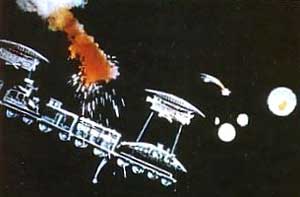 There's no longer dirigibles attached to the train, as it got burned up in the hollow sun. But the expedition memers have miraculously survived with neither burn nor scratch. There's no longer dirigibles attached to the train, as it got burned up in the hollow sun. But the expedition memers have miraculously survived with neither burn nor scratch.
They all set off afoot to investigate the landscape. There's a moon above steamy clouds. As the sun rises, the landscape begins to heat up. Fires flare from the ground. Everyone takes off their jackets & fan each other.
On the train was a refrigerator car the purpose of which we may wonder about, but in the murderous heat of the nearby sun it comes in handy.
Everyone except Krisoloff climb in the refrigerator car, which unfortunately freezes them solid. The professor never got inside the refrigerator car, nor did he burn up outside. He builds a fire, as if one were needed, finding a handy bundle of grass nearby to start it with. He soon thaws out the expedition.
The submarine was unharmed when the train crashed, so everyone climbs into it. They drive the submarine over land & off the edge of the planetoid. A parachute opens, & they fall easily back to earth, into the ocean.
In a cut-away we see everyone inside the submarine under the sea. A large porthole on the back wall of the sub permits them to watch sea creatures pass. Unexpectedly the engine bursts into flame & a bucket brigade is organized.
It seems the fire caused the submarine to explode, but the nose-cone lands in the middle of a busy sea port village before a cliff, & the expedition members are perfectly all right. In the end the Society treats it as having been a great success & fetes the heroic space voyagers.
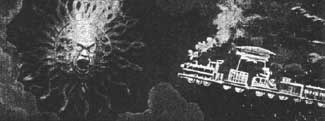 At twenty-four minutes, this is practically an epic feature film for Melies, the master of two-minute films. It's a great work of aburdist fantasy really, totally off the wall & purposely ridiculous.
At twenty-four minutes, this is practically an epic feature film for Melies, the master of two-minute films. It's a great work of aburdist fantasy really, totally off the wall & purposely ridiculous.
Humor & impossibilities trump science or logic, but one must nevertheless admit this as being one of the first truly great science fiction movies.
A collection of random directors' works from the time around 1904 would be dull for all but the die-hard early film buff, but where Georges Melies is concerned, everybody capable of delight will surely be captivated.
copyright © by Paghat the Ratgirl
|
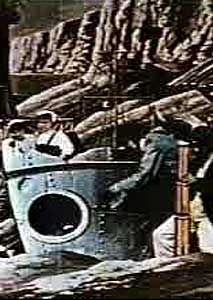

 Though not the equal of the A Trip to the Moon, that's only because that degree of astounding artfulness is not easily duplicated at will, though most certainly The Voyage through the Impossible is a film with its own extraordinary merits.
Though not the equal of the A Trip to the Moon, that's only because that degree of astounding artfulness is not easily duplicated at will, though most certainly The Voyage through the Impossible is a film with its own extraordinary merits. We next see Krisoloff's workspace, a warehouse sized building with large machinery for designing travel devices, & a beautiful set this is. There's a large cast of workers & geographic society visitors to the experimental engineering laboratory. It has just the right balance of realism & the fantastic to set a plausible mood for the implausible journey that will follow.
We next see Krisoloff's workspace, a warehouse sized building with large machinery for designing travel devices, & a beautiful set this is. There's a large cast of workers & geographic society visitors to the experimental engineering laboratory. It has just the right balance of realism & the fantastic to set a plausible mood for the implausible journey that will follow.
 There's no longer dirigibles attached to the train, as it got burned up in the hollow sun. But the expedition memers have miraculously survived with neither burn nor scratch.
There's no longer dirigibles attached to the train, as it got burned up in the hollow sun. But the expedition memers have miraculously survived with neither burn nor scratch.